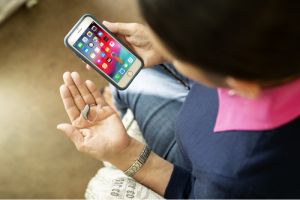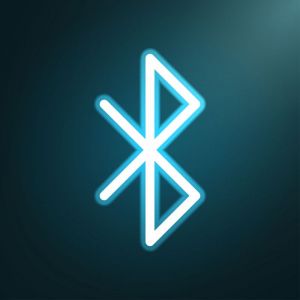|
www.HealthyHearing.com |
Bluetooth® hearing aids
By Megan Gerhart, AuD, audiologist, and Joy Victory, managing editor, Healthy Hearing  Reviewed by
Mandy Mroz, AuD, Former President, Healthy Hearing Reviewed by
Mandy Mroz, AuD, Former President, Healthy Hearing Last updated on: May 22nd, 2025 Hearing aids with Bluetooth technology help you stay connected to smartphones, televisions, tablets and other favorite audio devices. Many modern electronic devices these days come equipped with Bluetooth technology. This feature lets you stream audio between various devices, such as from a TV to your headphones, or from your phone to your car speakers. 
from your smartphone to your hearing aids. Bluetooth connection to Apple iPhone® devices and other smartphones is available in hearing aids from every major hearing aid manufacturer. When you pair the Bluetooth in your hearing aids to your smartphone, you can stream audio from phone calls, podcasts, music and other apps directly to your hearing aids. It varies by brand, but most hearing aids have a range of about 30 feet. Why do I want Bluetooth in my hearing aids?This advanced hearing aid technology offers many benefits to you, including: Personalized listening experienceWhen having a phone conversation, or listening to music, the audio signal from your smartphone can often stream to one hearing aid, or both. The volume will be matched to amplify sounds according to what you need based on your hearing loss. You also can adjust the volume of the input, depending on the model you have. This personalization lets you hear other sounds in the room if you choose, or you can immerse yourself in the streaming input from your device. Hands-free listening from across the roomSince streaming is a wireless technology, you do not have to hold your audio device closely to hear the sounds. Bluetooth technology allows you to move up to 30 feet away from the device, depending on the device used and the environment. For example, you can have your phone across the room from you and still be able to hear a podcast in your hearing aids. Remote control of your hearing aidsYou can remotely change the volume or program from either a streamer or from an app on your smartphone or smartwatch. This is especially useful if your hearing aids are too small to accommodate external controls, or you want to be discreet when adjusting your hearing aids in public. Reliability
Bluetooth® is an electronics industry standard protocol. It’s not unique to a particular hearing aid or hearing aid manufacturer, so there is uniformity and reliability in the way that it works across all devices. The platform has been tested and refined already, as it’s been in use for many years in the mobile phone industry. Bluetooth typesYou may hear several types of Bluetooth mentioned. "Classic" is used to connect larger audio devices. It has a long range and requires a lot of power. The power requirement is too large a burden for hearing aids, which need to have enough power to last at least 14 hours per day. However, hearing aids have been able to leverage specific protocols to connect to Bluetooth that exists in smartphones, i.e., the Apple Made for iPhone technology or Android Audio Streaming for Hearing Aids (ASHA) protocol). Bluetooth® LE AudioRecently, Bluetooth released a new standard called "Bluetooth LE Audio" which uses less power (the LE stands for "Low Energy"). This technology is added to some newer hearing aids, like the Oticon Intent™, because it gives hearing aids the ability to connect to other Bluetooth-enabled devices without draining the batteries too quickly. Newer versions of the iPhone and Android™/Samsung phones now have LE Audio compatability. Auracast™The Bluetooth LE technology in hearing aids will make them ready for Auracast, a new Bluetooth capability that lets multiple people connect to audio in a public setting, such as airport announcements or the TV at a sports bar. It will almost certainly improve accessibility for people with hearing aids, although it remains to be seen how widely offered it will become. Currently only some models, like Oticon Intent, can access Auracast broadcasts.
Will my smartphone connect to hearing aids?Made for iPhone™Certain hearing aids can communicate with iPhone, iPad® and Apple Watch® devices. This technology allows connection without extreme stress on battery power. Most hearing aid manufacturers have released hearing aids that implement this Bluetooth technology, marketed as Made for iPhone. Visit the Apple website for a current listing of specific hearing aids that are compatible. Android phonesSeveral hearing aid brands can also stream to Android-based phones using version 10.0 or higher. Check the version of your phone before visiting your hearing care provider so you know what options are available. FAQ: Bluetooth hearing aidsCan Bluetooth help me watch TV?Yes, depending on the model of hearing aid and television, you can stream the signal from a TV via Bluetooth to your hearing aids. Often you will need an adapter to wirelessly send the signal to your hearing aids. Talk to your hearing care provider for suggestions. Does streaming cause my battery to drain faster?Most manufacturers will estimate battery usage times based on non-streaming and streaming. The hearing aids will be working harder when streaming, and therefore the battery can drain faster. Usually this doesn’t negatively impact the wearer’s experience, but if you are often on the phone for hours or plan to stream TV all day, you may want to discuss this with your hearing healthcare provider when buying your next pair of hearing aids. Can Bluetooth help me hear conversations better?Yes, there are Bluetooth-enabled remote microphones that your conversation partner can clip on their lapel, or that can be placed on a table to enhance the voices seated close by. This can be helpful in noisy restaurants or lecture style events. How do I connect my hearing aids to my smartphone?Open up the Bluetooth options on your smartphone and you should see the hearing aids detected. Select the hearing aids and they will be paired. If you're having trouble pairing your hearing aids, turn the hearing aids on and off and try to detect them with your smartphone again. If this isn’t successful, talk to your hearing care professional. What if I don't have Bluetooth in my hearing aids?Nearly all brands of hearing aids sell a separate go-between device to allow you to connect your hearing aids to Bluetooth-enabled devices, such as a smartphone. These are typically called streamers. Usually, the streamer is worn around the neck or placed in a pocket for hands-free operation. Speak to your hearing care provider about if a streamer option is necessary for you. What about OTC hearing aids and Bluetooth?Some OTC hearing aids also have the capability of connecting to devices via Bluetooth, but not all. Discuss with your hearing care professional about your options. Find out moreYour hearing care provider can help you learn more about your Bluetooth hearing aids, or help you select a new pair. they can also recommend assistive listening devices like streamers and remote microphones. If you need help with hearing loss or hearing aids, you can use our directory to find hearing care providers near you. Apple, the Apple logo, iPhone, iPad, and Apple Watch are trademarks of Apple Inc., registered in the U.S. and other countries. Use of the Made for Apple badge means that an accessory has been designed to connect specifically to the Apple product(s) identified in the badge and has been certified by the developer to meet Apple performance standards. Apple is not responsible for the operation of this device or its compliance with safety and regulatory standards. Android is a trademark of Google LLC. The Bluetooth® word mark and logos are registered trademarks owned by Bluetooth SIG, Inc. The Auracast™ word mark and logos are trademarks owned by the Bluetooth SIG. Any use of such marks by Demant is under license. Other trademarks and trade names are those of their respective owners. Megan Gerhart, audiologistMegan Gerhart, AuD, is an audiologist with experience in pediatrics through geriatrics. She has worked in a variety of settings including private practice, ENT clinics, as well as overseeing audiology programs within school districts. Her passion is being a partner to those with hearing loss on their journey to better hearing. Joy Victory, managing editor, Healthy Hearing
You are reading about: Related topics
More information about hearing loss, hearing aid brands, assistive devices and tinnitus. Featured clinics near me
Earzlink Hearing Care - Reynoldsburg Find a clinicWe have more hearing clinic reviews than any other site! Related contentThe Healthy Hearing Report |
|
www.HealthyHearing.com |
Bluetooth® hearing aids
By Megan Gerhart, AuD, audiologist, and Joy Victory, managing editor, Healthy Hearing  Reviewed by
Mandy Mroz, AuD, Former President, Healthy Hearing Reviewed by
Mandy Mroz, AuD, Former President, Healthy Hearing Last updated on: May 22nd, 2025 Hearing aids with Bluetooth technology help you stay connected to smartphones, televisions, tablets and other favorite audio devices. |




 Joy Victory has extensive experience editing consumer health information. Her training in particular has focused on how to best communicate evidence-based medical guidelines and clinical trial results to the public. She strives to make health content accurate, accessible and engaging to the public.
Joy Victory has extensive experience editing consumer health information. Her training in particular has focused on how to best communicate evidence-based medical guidelines and clinical trial results to the public. She strives to make health content accurate, accessible and engaging to the public.